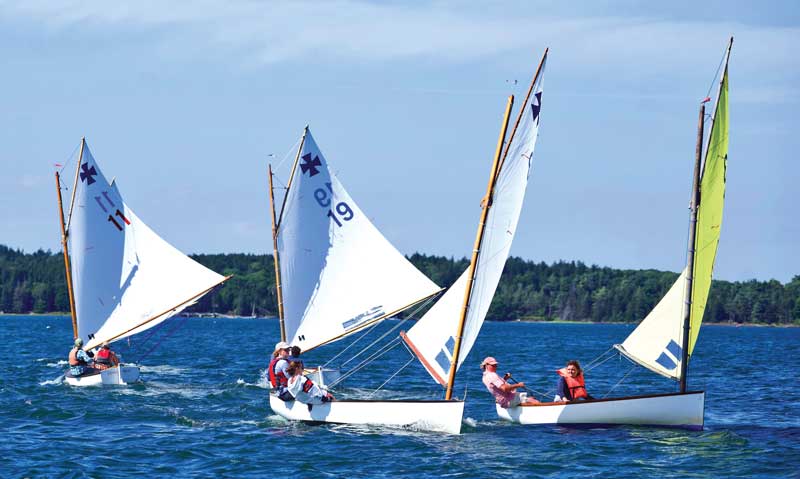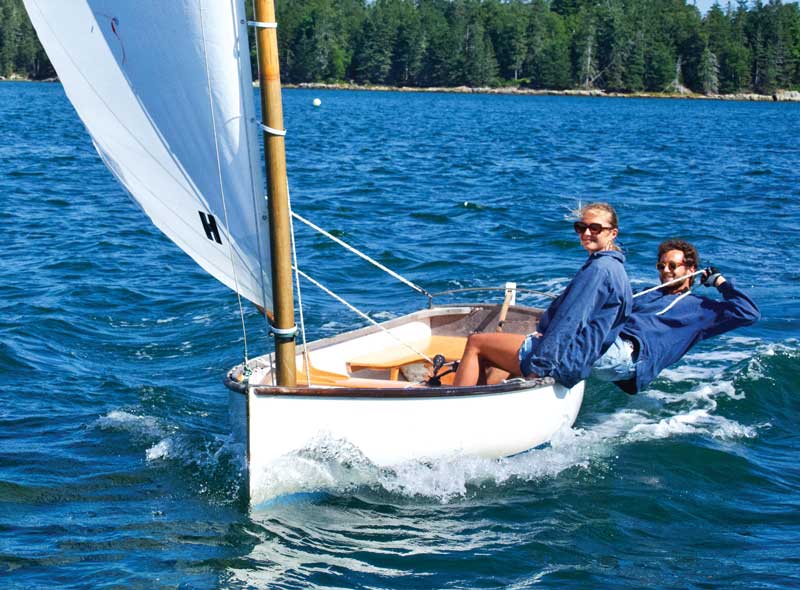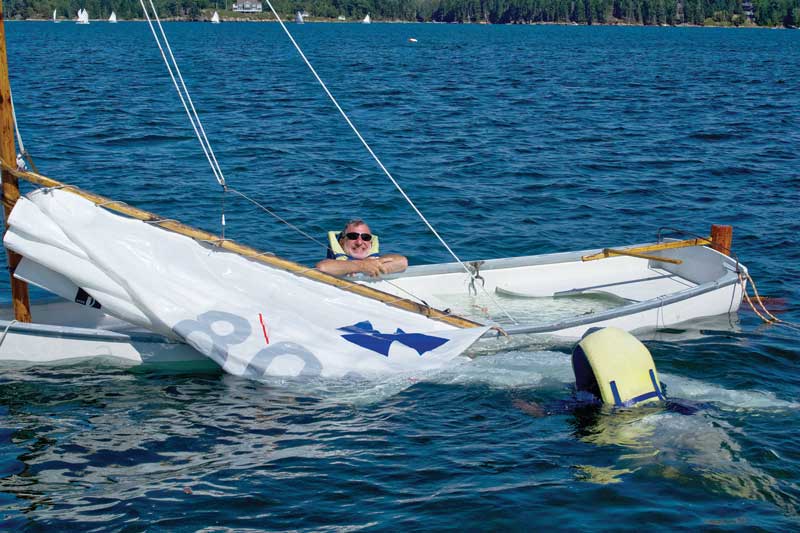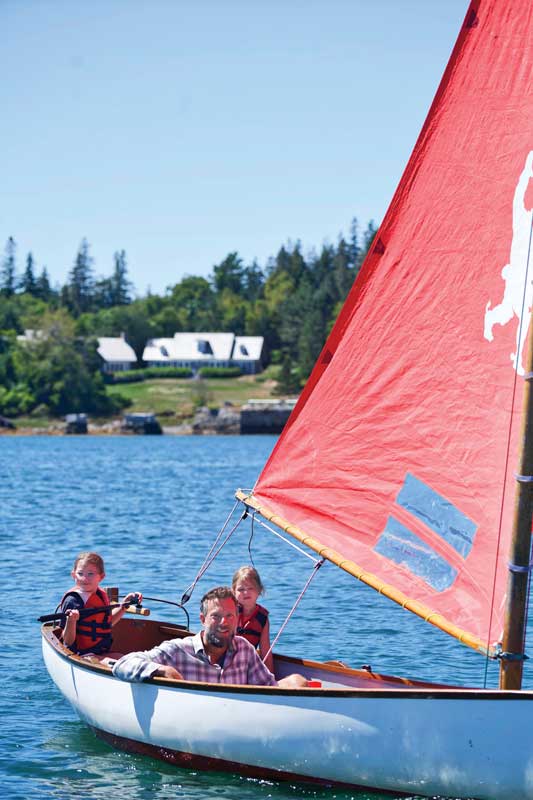Photographs by Polly Saltonstall

The North Haven Dinghy fleet is known as the oldest continuously raced one-design fleet in North America, and some might say the world. But by the early years of this century, many of the boats were showing their age, and despite the introduction of a fiberglass version, fewer and fewer were lining up on the starting line in the Fox Islands Thoroughfare for the local yacht club’s biweekly summer races. A good weekend might see four or five boats competing, most sailed by elderly skippers.
Flash forward to this summer, when a whopping 20 North Haven Dinghies, many with parents and their children as crew, competed in the club’s iconic Mill River Race, which these sailors now consider to be their annual championship regatta.
It’s been an exciting revival, spearheaded by avid sailors who refused to let the sprightly gaff-rigged catboats cruise into oblivion. The fleet now is backed by a foundation, which owns a handful of boats that it allows members of the public to sail for free, and offers free clinics for those who want to learn the tricky points of handling a North Haven Dinghy. In addition, the foundation has made its boats available to the yacht club’s sailing classes, and has set up a boat-based competition for kids, with games including water-balloon fights and obstacle courses.
The man driving much of this is Will Holmgren, a 43-year-old summer resident who worked as a sailing instructor at the Casino (the name of the local yacht club) in the early 2000s as a teenager and became enamored of the class when he crewed for one of the fleet’s seasoned sailors and won races. That led him eventually to buy his own North Haven Dinghy, which he named Falstaff.
“Suddenly I was hooked,” recounted Holmgren, who these days often races with his two young daughters, Athena, 5, and Beatrix, 8, as crew. “What appealed to me from the get-go was the sense of the history and plowing through the same waters that other people had sailed for so many years. The wind I’m feeling now is the same wind they felt. Also, I just really love how low you are in the water. The simplicity allows you to feel so relaxed. Everything is at your fingertips.”

But even as Holmgren became more interested, he saw that the number of other Dinghy sailors was dropping. As vacation patterns shifted and families no longer spent the whole summer on North Haven and Vinalhaven, more owners were keeping their boats in storage.
“There wasn’t a new set of souls lining up at the gate to sail Dinghies,” Holmgren said. “It makes less sense to launch a boat if you are not there for very long.”
In addition, the local sailing program, which for years had hosted so-called “midget” races in North Haven Dinghies replaced the craft as teaching and racing tools with Optimists. In those Dinghy midget races, the skipper had to be 13 or younger. Parents often ended up “crewing” for their children, and in the process teaching them to sail, and often, to appreciate the boats.
About four years ago, after chatting with several old-time racers about the challenges facing the dwindling fleet, Holmgren set up the foundation with the help of other Dinghy sailors, and created a North Haven Dinghy web site (nhdinghy.org). In addition to the foundation’s work acquiring boats and making them available to a wider audience, the North Haven Dinghy revival has included improving communications among Dinghy owners and sailors, including discussions about standardizing the fleet. That resulted in a mass order of 25 new sails and annual weigh-ins to equalize the boats. Many of the new sails are brightly colored and feature fun images—Holmgren’s own sail, for example, is red and has an outline on it of a chubby Falstaff character wielding a sword.
The colorful sails and images, as well as the Dinghy GP, which is the name of the boat-based competition for kids, are intended to appeal to young sailors. “My general thesis is that the more fun you can make it, the more the kids will like it,” said Holmgren, whose long-term plan is for these same kids to become adult Dinghy fans.
“If the Casino is the heartbeat (of the summer community), the North Haven Dinghy is its sailing heritage. We need to build up a structure so this can grow and we can get more people involved.”
The effort has been paying off. Last summer, according to Holmgren, 46 people reserved one of the communal boats, 56 attended a sailing clinic, and 44 youngsters sailed dinghies through the yacht club’s youth programs.

With an overall length of 14 feet, 6 inches, a beam of 4 feet, 11 inches, and a big 118-square-foot gaff mainsail, North Haven Dinghies can be a handful to sail. Their shallow draft (13 inches with the centerboard up and almost 4 feet with it down) and big sail make them surprisingly fast, especially downwind with the peak lowered and the centerboard up. But they also carry 350 pounds of lead ballast in the form of loose ingots stashed in the bilge, which gives them the heft of a much larger boat and precludes quick moves. They can capsize easily, as several racers discovered this past summer. Styrofoam in the bow theoretically keeps the boat from sinking in the event of a capsize, although racers have been debating various ways to improve flotation after one capsized boat sank below the gunnels and was difficult to bail. Additional characteristics include a narrow entry in the bow and a distinctive wineglass transom. While class rules prohibit hiking straps, most sailors have found a way around that by storing oars under the thwarts and alongside the centerboard box, which then can be used as foot-holds for hiking.
Competition is fierce. Local knowledge of wind and tidal patterns in the Thoroughfare—the body of water separating North Haven and Vinalhaven—and its coves can make a big difference when racing, as can understanding how to trim sails and balance the boat. A number of college racers and top sailors have gotten their start in the Dinghies. That includes Cam Lewis, who has won world championships in Lasers, Finns, and 505s, crewed in the America’s Cup, and was part of a team that set what was then a world record for circumnavigating the globe. “I started racing sailboats in the midget series on the Fox Islands Thoroughfare in North Haven Dinghies,” he said. “By the time I was 10, I was going out singlehanded and winning races. That was the boat that I started off racing.”
A generation or so behind Lewis, Ollie Dietter learned to sail in the Optis and had only been in a North Haven Dinghy once or twice when he was hired by the foundation as a Dinghy instructor. He learned quickly but still remains awed by the folks who grew up sailing the boats.
“I like to consider myself to be a fairly good sailor. But here you can go out and get your butt kicked by these super old people,” said Dietter, who now races keel boats on the sailing team at Northeastern University.
During the several years that he taught the foundation’s sailing clinics, Dietter said he’s seen more young people sailing with parents, as well as people who had not been sailing in a while but wanted to get back into it.

Dinghies have been racing in the Fox Islands Thoroughfare since the late 1800s. By 1900, there were 11 boats racing and the fleet grew steadily over the next decades. Photos taken in the 1950s show close to 30 boats on the line. The fleet grew to 50 or more and remained quite healthy until the early 1970s when the old wooden boats, many almost a century old, became difficult to maintain. A group of summer residents, including Richard Saltonstall Jr. (my father), and his first cousin, George Lewis Jr., had a fiberglass mold made. According to Holmgren, 31 fiberglass boats were built over several years. The mold for those boats is stored at J.O. Brown’s Boatyard, now known to most as simply Brown’s Boatyard, on North Haven; and Holmgren hopes to have the yard build at least one new boat this winter. He said he has a list of families who have been inspired by the boats and hope to buy one.
But thanks to the foundation, people who do not own a North Haven Dinghy can easily take one out for a sail or race. The foundation owns and maintains five of the fiberglass boats, and has the use of several more that are on loan. Would-be sailors can sign up to use one of the boats via an easy-to-use app created by Holmgren. The first time someone opens the app it asks if they are a real person, and requires them to email Holmgren with details about themselves and their sailing experience.
“Part of the automated process is they are instantly emailed from the Dinghy Initiative account to verify that they are a real sailor,” said Holmgren who gets the responses on his phone.
“There is something really neat about having someone write in and say, I’m a flesh-and-bone sailor.”
After passing a test demonstrating their ability to handle the boat, people can sign one out to race or just take it out for a sail. Instructors working for the foundation administer the tests; they also host weekly clinics during the summer, teaching sailors the finer points of handling the tricky little catboats. A key lesson is learning how to jibe the big gaff-rigged main.
“What the foundation has done is to take anyone, wherever they are, and offer a free pass to take out a Dinghy, and that is cool,” said Holmgren.
He has received email queries via the app from as far away as Switzerland. One sailor from New Orleans who had heard about the foundation program came out to North Haven just to sail and race a Dinghy. Closer to home, Dana Peterson, a Vinalhaven summer resident, heard about the foundation, got in touch with Holmgren, and has become a dedicated North Haven Dinghy fan as a result, although so far he just goes for leisurely sails and has not yet raced.
“It’s been thrilling,” he said. “I’ve had so much fun.”
Holmgren’s goal is to get 40 dinghies on the starting line by 2040. He’s optimistic that that can happen with the help of the foundation and its dedicated group of supporters.
“There is a kind of insouciant naughtiness to jaunting off in a small boat. Capturing that feeling is part of what the North Haven Dinghy is all about,” he said. “This is not merely about our Fox Islands sailing heritage; it’s a bona fide anchor of Maine’s history. We have been doing one-design sailboat racing here for longer than anyone in America.”
✮
Polly Saltonstall is MBH&H’s editor at large. She learned to sail in a North Haven Dinghy, and has won a few Dinghy races over the years.
To support the foundation’s mission visit: nhdinghy.org/give to learn more.
Read a 2008 MBH&H article about the Mill River Race HERE.

Which Is Older, the Water Wag or the North Haven Dinghy?
The North Haven Dinghy class dates back to the early 1880s, when summer residents began racing in spritsail-rigged dinghies. Summer resident William Weld took on the fleet in 1883 with a tender from his big yacht Gitana. He lost and went home to Massachusetts, where he had a faster boat built. The next summer he beat all challengers, prompting his brother, Dr. Charles C. Weld, to commission four copies from James O. Brown of North Haven. Dr. Weld eventually helped Brown start a boatyard, J.O. Brown and Son, that still functions today and is run by Brown’s descendants.
Those first four boats began racing in 1885, according to an early account by Tucker Daland, one of the summer colony’s founders and owner of one of the four. The next year, the design was modified from a spritsail to a gaff rig, with the mast set in the eyes of the boat. Two races in the new design took place Aug. 15, 1887. The first involved just women and was won by Ellen Hayward, who went on to compete in a second race against two men. The men, both seasoned yachtsmen, got into a luffing match, allowing Hayward, a far less experienced racer, to sail past them and win in a borrowed boat named Griffin. Her prize, given by Dr. Weld, was a sloop named Wayward, which she and her husband sailed on Penobscot Bay for many years, according to an account she wrote much later in life.
The dates are important because in Ireland, Dublin’s Water Wags fleet first raced on April 12, 1887. Some argue this makes the Water Wag the world’s oldest one-design. Others note that North Haven began racing a version of its Dinghy in 1885, even though the design was later modified. But the design of the Water Wag also was modified since that fleet’s “first” race, which involved doubled-ended clincher boats, according to the official Water Wag web page (waterwags.com). The design was changed in 1899 to include a transom, and again in 1901 to add a jib, among other modifications. The Water Wags racing today still are built from wood.
The North Haven Dinghy design was standardized in 1919 when the firm of yacht designer John Alden was hired to take the lines off one of the existing boats—Sam Crocker drew up that first set of plans. Alden’s firm produced a second set of drawings in 1925, including plans for a Bermudan sloop rig that were never used. The fiberglass version of North Haven Dinghies was introduced in the 1970s.
So, you be the judge. For my part, and I’ll admit I’m biased, I give the North Haven Dinghy the title of oldest. —Polly Saltonstall






